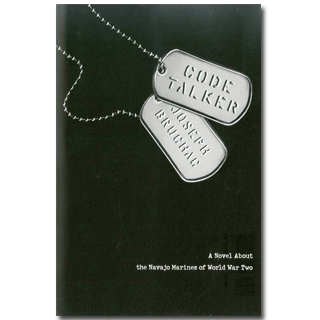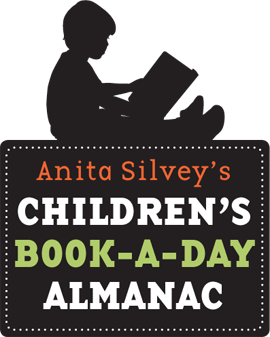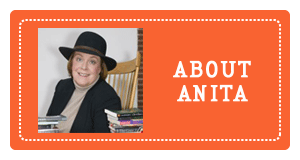
A FEW OTHER EVENTS FOR
AUGUST 14:
- Happy birthday Alice Provensen (A Glorious Flight, A Year at Maple Hill Farm), Gary Larson (The Far Side comic series), and Steve Martin (Late for School).
- It’s the birth date of Ernest Thayer (1863-1940), Casey at the Bat.
- In 1848, the Oregon Territory is created by act of the U.S. Congress. Read Joshua’s Oregon Trail Diary series by Patricia Hermes.
- In 1967, the United Kingdom Marine Broadcasting Offences Act declares participation in offshore “pirate radio” illegal. Read Radio Radio by Graham Marks.
- It’s National Creamsicle Day. Read and/or play with Ice Cream Truck by Peter Lippman; it’s a book and a toy.
In 1982 the United States Senate designated August 14 as National Code Talkers Day. In his address that day, Dennis DeConcini, an Arizona Senator, said, “Since the Code Talkers’ work required absolute secrecy, they never enjoyed the national acclaim they so much deserved. I do not want this illustrious yet unassuming group of Navajo marines to fade into history without notice.” The Navajo Nation Council has also marked this day as a tribal holiday.
Although unacknowledged until 1969, the Navajo Code Talkers invented an unbreakable military code for relaying information on the Pacific front in World War II. Hundreds of these brave marines went into battle in some of the fiercest fighting of the war. They successfully conveyed military intelligence without the Japanese ever deciphering their transmissions, which were based on the complex nature of the Navajo language. These soldiers, who as children had often been punished for speaking Navajo in government schools, used their native tongue to help save America.
In 1992 Nathan Aaseng wrote Navajo Code Talkers, an information book for young readers ages eight through twelve that provides an excellent overview of the subject. But the best book on this topic, Joseph Bruchac’s Code Talker, presents the account of a young Navajo boy, Ned Begay, who tells his story years later in a narrative addressed to his grandchildren. In early scenes, readers witness Ned’s experiences at boarding school where everything is stripped away from him: his possessions, his hair, his language, and even his name. He learns how to thrive in this environment, but never gives up his Navajo identity or the use of his language. When World War II begins, Ned is just the kind of educated young man that the marines need in their new unit, the Navajo Code Talkers. At sixteen, he heads to the Pacific, to take part in all the major battles—from Guadalcanal to Iowa Jima.
Told in straightforward and precise language, the book does not glorify war, but it does convey the bravery and endurance of the marines as they fought the Japanese. In this fictional account, Bruchac includes a vast amount of historical information—all of it worked into the narrative. To research the book, he talked to former Code Talkers about their experience and was able to identify small details that make the story seem so real. Sometimes earmarked as a young adult book, Code Talker is completely accessible to ten- to twelve-year-olds both in narrative style and content and stands as one of our best novels for children about the events of World War II.
Anyone age ten to one hundred, who wants to understand this chapter in American history, will be riveted by Joseph Bruchac’s powerful novel. It has often been adopted for one-city reads or one-state reads title because it works for such a wide range of people. In the end, the story of the Code Talkers stands as a testament to the power of language—and why all languages should be respected and kept alive.
Here’s a passage from Code Talker:
“What are you doing?” I said in Navajo, just loud enough so that they could hear. But they did not answer me.
Instead, they pushed me down into that hard wooden chair and held me firmly—as if I were a sheep about to be sheared. Then another boy with a big pair of scissors chopped off my hair. He did it so quickly that it was over almost before I knew it. Another stunned child was being led in, and shoved into that chair even before I was out the door.
Both boys and girls had their hair cut. The only difference was that the hair of the girls was left a little longer than the boys. But I could see from the looks on their faces that losing most of their beautiful hair made those girls feel the same way I felt. Naked and ashamed.
Not only was our hair stripped away. After being shorn, we were led into two separate buildings, one for the boys and another for the girls. Once we were inside, we were made to take off all our fine clothing and our jewelry. We never saw those clothes or jewels again. Years later I learned that our squash-blossom necklaces and turquoise bracelets, earrings and hair ornaments and silver belts, were sold to white men and women.
Originally posted August 14, 2011. Updated for .






I am not familiar with this book and it might not have appealed to me as a child but I will try it on my nephews when they are a little older. I am reminded of Herbert Zim’s Codes and Secret Writing which I used to borrow from my elementary school library earnestly to try out different codes.
This is definitely best appreciated by those readers who enjoy war books — but the Code Talker history holds wide appeal. It has been very successfully used as an All Community Reads selection.
Thanks for posting this – our treatment of Native Americans is not so overtly shameful today, but it still exists. These men paid a price as children, yet still gave back to “their” country.